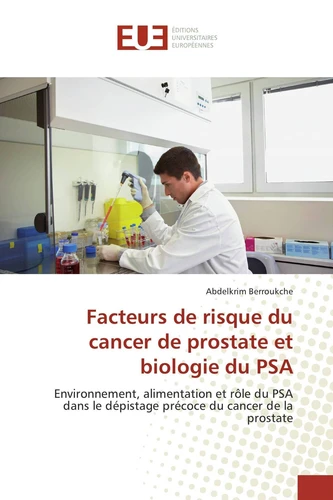Facteurs de risque du cancer de prostate et biologie du PSA. Environnement, alimentation et rôle du PSA dans le dépistage précoce du cancer de la prostate
Par :Formats :
Définitivement indisponible
Cet article ne peut plus être commandé sur notre site (ouvrage épuisé ou plus commercialisé). Il se peut néanmoins que l'éditeur imprime une nouvelle édition de cet ouvrage à l'avenir. Nous vous invitons donc à revenir périodiquement sur notre site.
- Paiement en ligne :
- Livraison à domicile ou en point Mondial Relay indisponible
- Retrait Click and Collect en magasin gratuit
- Réservation en ligne avec paiement en magasin :
- Indisponible pour réserver et payer en magasin
- Nombre de pages292
- PrésentationBroché
- FormatPoche
- Poids0.433 kg
- Dimensions15,0 cm × 22,0 cm × 0,0 cm
- ISBN978-3-8417-4013-7
- EAN9783841740137
- Date de parution09/10/2014
- CollectionOMN.UNIV.EUROP.
- ÉditeurUniv Européenne
Résumé
Prostate cancer is the second most common cause of cancer worldwide after lung cancer. Diet and lifestyle play a crucial role in prostate cancer biology and tumourigenesis. Dietary agents have gained considerable attention. Human prostate-specific antigen (PSA or KLK3) is an important marker for the diagnosis and management of prostate cancer. This is an androgen-regulated glycoprotein of the kallikrein-related protease family secreted by prostatic epithelial cells.
Its physiological function is to cleave semenogelins in the seminal coagulum.
Its physiological function is to cleave semenogelins in the seminal coagulum.
Prostate cancer is the second most common cause of cancer worldwide after lung cancer. Diet and lifestyle play a crucial role in prostate cancer biology and tumourigenesis. Dietary agents have gained considerable attention. Human prostate-specific antigen (PSA or KLK3) is an important marker for the diagnosis and management of prostate cancer. This is an androgen-regulated glycoprotein of the kallikrein-related protease family secreted by prostatic epithelial cells.
Its physiological function is to cleave semenogelins in the seminal coagulum.
Its physiological function is to cleave semenogelins in the seminal coagulum.

